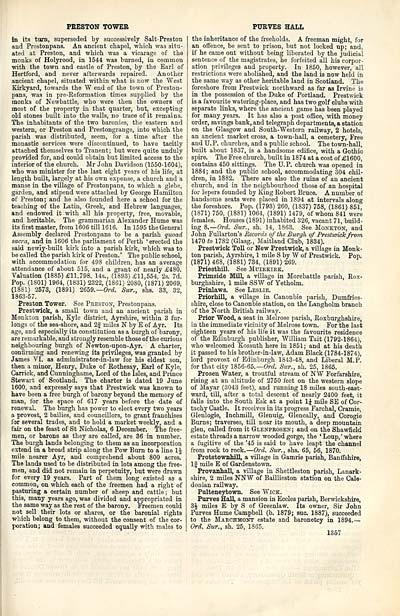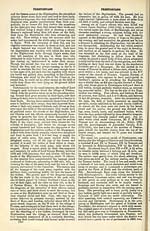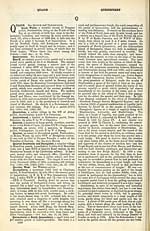Ordnance gazetteer of Scotland
(1365) Page 1357
Download files
Complete book:
Individual page:
Thumbnail gallery: Grid view | List view

PRESTON TOWER
In its turn, superseded by successively Salt- Preston
and Prestonpans. An ancient chapel, which was situ-
ated at Preston, and which was a vicarage of the
monks of Holyrood, in 1544 was burned, in common
with the town and castle of Preston, by the Earl of
Hertford, and never afterwards repaired. Another
ancient chapel, situated within what is now the West
Kirkyard, towards the W end of the town of Preston-
pans, was in pre-Reformation times supplied by the
monks of Newbattle, who were then the owners of
most of the property in that quarter, but, excepting
old stones built into the walls, no trace of it remains.
The inhabitants of the two baronies, the eastern and
western, or Preston and Prestongrange, into which the
parish was distributed, seem, for a time after the
monastic services were discontinued, to have tacitly
attached themselves to Tranent; but were quite unduly
provided for, and could obtain but limited access to the
interior of the church. Mr John Davidson (1550-1604),
who was minister for the last eight years of his life, at
length built, largely at his own expense, a church and a
manse in the village of Prestonpans, to which a glebe,
garden, and stipend were attached by George Hamilton
of Preston; and he also founded here a school for the
teaching of the Latin, Greek, and Hebrew languages,
and endowed it with all his property, free, movable,
and heritable. The grammarian Alexander Hume was
its first master, from 1606 till 1616. In 1595 the General
Assembly declared Prestonpans to be a parish quoad
sacra, and in 1606 the parliament of Perth 'erected the
said newly-built kirk into a parish kirk, which was to
be called the parish kirk of Preston.' The public school,
with accommodation for 498 children, has an average
attendance of about 515, and a grant of nearly £480.
Valuation (1885) £11,798, 14s., (1893) £11,554, 2s. 7d.
Pop. (1801) 1964, (1831) 2322, (1861) 2080, (1871) 2069,
(1881) 2573, (1891) 2659.— Oral. Sur., shs. 33, 32,
1863-57.
Preston Tower. See Preston, Prestonpans.
Prestwick, a small town and an ancient parish in
Monkton parish, Kyle district, Ayrshire, within 3 fur-
longs of the sea-shore, and 2f miles N by E of Ayr. Its
age, and especially its constitution as a burgh of barony,
are remarkable, and strongly resemble those of the curious
neighbouring burgh of Newton-upon-Ayr. A charter,
confirming and renewing its privileges, was granted by
James VI. as administrator-in-law for his eldest son,
then a minor, Henry, Duke of Rothesay, Earl of Kyle,
Carrick, and Cunninghame, Lord of the Isles, and Prince
Stewart of Scotland. The charter is dated 19 June
1600, and expressly says that Prestwick was known to
have been a free burgh of barony beyond the memory of
man, for the space of 617 years before the date of
renewal. The burgh has power to elect every two years
a provost, 2 bailies, and councillors, to grant franchises
for several trades, and to hold a market weekly, and a
fair on the feast of St Nicholas, 6 December. The free-
men, or barons as they are called, are 36 in number.
The burgh lands belonging to them as an incorporation
extend in a broad strip along the Pow Burn to a line 1J
mile nearer Ayr, and comprehend about 800 acres.
The lands used to be distributed in lots among the free-
men, and did not remain in perpetuity, but were drawn
for every 19 years. Part of them long existed as a
common, on which each of the freemen had a right of
pasturing a certain number of sheep and cattle; but
this, many years ago, was divided and appropriated in
the same way as the rest of the barony. Freemen could
not sell their lots or shares, or the baronial rights
which belong to them, without the consent of the cor-
poration; and females succeeded equally with males to
PTTRVES HALL
the inheritance of the freeholds. A freeman might, for
an offence, be sent to prison, but not locked up; and,
if he came out without being liberated by the judicial
sentence of the magistrates, he forfeited all his corpor-
ation privileges and property. In 1850, however, all
restrictions were abolished, and the land is now held in
the same way as other heritable land in Scotland. The
foreshore from Prestwick northward as far as Irvine is
in the possession of the Duke of Portland. Prestwick
is a favourite watering-place, and has two golf clubs with
separate links, where the ancient game has been played
for many years. It has also a post office, with money
order, savings bank, and telegraph departments, a station
on the Glasgow and South- Western railway, 2 hotels,
an ancient market cross, a town-hall, a cemetery, Free
and U.P. churches, and a public school. The town -hall,
built about 1837, is a handsome edifice, with a Gothic
spire. The Free church, built in 1874 at a cost of £1600,
contains 450 sittings. The U.P. church was opened in
1884; and the public school, accommodating 304 chil-
dren, in 1882. There are also the ruins of an ancient
church, and in the neighbourhood those of an hospital
for lepers founded by King Robert Bruce. A number of
handsome seats were placed in 1894 at intervals along
the foreshore. Pop. (1793) 260, (1837) 758, (1861) 851,
(1871) 750, (1881) 1064, (1891) 1479, of whom 841 were
females. Houses (1891) inhabited 326, vacant 71, build-
ing 8. — Ord. Sur., sh. 14, 1863. See Monkton, and
John Fullarton's Records of the Burgh of Prestwick from
1470 to 1782 (Glasg., Maitland Club, 1834).
Prestwick Toll or New Prestwick, a village in Monk-
ton parish, Ayrshire, 1 mile S by W of Prestwick. Pop.
(1871) 468, (1881) 734, (1891) 269.
Priesthill. See Muirkirk.
Primside Mill, a village in Morebattle parish, Rox-
burghshire, 1 miie SSW of Yetholm.
Prinlaws. See Leslie,
Priorhill, a village in Canonbie parish, Dumfries-
shire, close to Canonbie station, on the Langholm branch
of the North British railway.
Prior Wood, a seat in Melrose parish, Roxburghshire,
in the immediate vicinity of Melrose town. For the last
eighteen years of his lite it was the favourite residence
of the Edinburgh publisher, William Tait (1792-1864),
who welcomed Kossuth here in 1851; and at his death
it passed to his brother-in-law, Adam Black (1784-1874),
lord provost of Edinburgh 1843-48, and Liberal M.P.
for that city 1856-65.— Ord. Sur., sh. 25, 1865.
Prosen Water, a troutful stream of NW Forfarshire,
rising at an altitude of 2750 feet on the western slope
of Mayar (3043 feet), and running 18 miles south-east-
ward, till, after a total descent of nearly 2400 feet, it
falls into the South Esk at a point 1 J mile SE of Cor-
tachy Castle. It receives in its progress Farchal, Cramie,
Glenlogie, Inchmill, Glenuig, Glencally, and Corogie
Burns; traverses, till near its mouth, a deep mountain
glen, called from it Glenprosen; and on the Shawfield
estate threads a narrow wooded gorge, the ' Loup, ' where
a fugitive of the '45 is said to have leapt the channel
from rock to rock. — Ord. Sur., shs. 65, 56, 1870.
Protstownhill, a village in Gamrie parish, Banffshire,
1 j mile E of Gardenstown.
ProvanhalL a village in Shettleston parish, Lanark-
shire, 2 miles NNW of Baillieston station on the Cale-
donian railway.
Pulteneytown. See Wick.
Purves Hall, a mansion in Eccles parish, Berwickshire,
3^ miles E by S of Greenlaw. Its owner, Sir John
Purves Hume Campbell (b. 1879; sue. 1887), succeeded
to the Marchmont estate and baronetcy in 1894. —
Ord. Sur., sh. 25, 1865.
1357
In its turn, superseded by successively Salt- Preston
and Prestonpans. An ancient chapel, which was situ-
ated at Preston, and which was a vicarage of the
monks of Holyrood, in 1544 was burned, in common
with the town and castle of Preston, by the Earl of
Hertford, and never afterwards repaired. Another
ancient chapel, situated within what is now the West
Kirkyard, towards the W end of the town of Preston-
pans, was in pre-Reformation times supplied by the
monks of Newbattle, who were then the owners of
most of the property in that quarter, but, excepting
old stones built into the walls, no trace of it remains.
The inhabitants of the two baronies, the eastern and
western, or Preston and Prestongrange, into which the
parish was distributed, seem, for a time after the
monastic services were discontinued, to have tacitly
attached themselves to Tranent; but were quite unduly
provided for, and could obtain but limited access to the
interior of the church. Mr John Davidson (1550-1604),
who was minister for the last eight years of his life, at
length built, largely at his own expense, a church and a
manse in the village of Prestonpans, to which a glebe,
garden, and stipend were attached by George Hamilton
of Preston; and he also founded here a school for the
teaching of the Latin, Greek, and Hebrew languages,
and endowed it with all his property, free, movable,
and heritable. The grammarian Alexander Hume was
its first master, from 1606 till 1616. In 1595 the General
Assembly declared Prestonpans to be a parish quoad
sacra, and in 1606 the parliament of Perth 'erected the
said newly-built kirk into a parish kirk, which was to
be called the parish kirk of Preston.' The public school,
with accommodation for 498 children, has an average
attendance of about 515, and a grant of nearly £480.
Valuation (1885) £11,798, 14s., (1893) £11,554, 2s. 7d.
Pop. (1801) 1964, (1831) 2322, (1861) 2080, (1871) 2069,
(1881) 2573, (1891) 2659.— Oral. Sur., shs. 33, 32,
1863-57.
Preston Tower. See Preston, Prestonpans.
Prestwick, a small town and an ancient parish in
Monkton parish, Kyle district, Ayrshire, within 3 fur-
longs of the sea-shore, and 2f miles N by E of Ayr. Its
age, and especially its constitution as a burgh of barony,
are remarkable, and strongly resemble those of the curious
neighbouring burgh of Newton-upon-Ayr. A charter,
confirming and renewing its privileges, was granted by
James VI. as administrator-in-law for his eldest son,
then a minor, Henry, Duke of Rothesay, Earl of Kyle,
Carrick, and Cunninghame, Lord of the Isles, and Prince
Stewart of Scotland. The charter is dated 19 June
1600, and expressly says that Prestwick was known to
have been a free burgh of barony beyond the memory of
man, for the space of 617 years before the date of
renewal. The burgh has power to elect every two years
a provost, 2 bailies, and councillors, to grant franchises
for several trades, and to hold a market weekly, and a
fair on the feast of St Nicholas, 6 December. The free-
men, or barons as they are called, are 36 in number.
The burgh lands belonging to them as an incorporation
extend in a broad strip along the Pow Burn to a line 1J
mile nearer Ayr, and comprehend about 800 acres.
The lands used to be distributed in lots among the free-
men, and did not remain in perpetuity, but were drawn
for every 19 years. Part of them long existed as a
common, on which each of the freemen had a right of
pasturing a certain number of sheep and cattle; but
this, many years ago, was divided and appropriated in
the same way as the rest of the barony. Freemen could
not sell their lots or shares, or the baronial rights
which belong to them, without the consent of the cor-
poration; and females succeeded equally with males to
PTTRVES HALL
the inheritance of the freeholds. A freeman might, for
an offence, be sent to prison, but not locked up; and,
if he came out without being liberated by the judicial
sentence of the magistrates, he forfeited all his corpor-
ation privileges and property. In 1850, however, all
restrictions were abolished, and the land is now held in
the same way as other heritable land in Scotland. The
foreshore from Prestwick northward as far as Irvine is
in the possession of the Duke of Portland. Prestwick
is a favourite watering-place, and has two golf clubs with
separate links, where the ancient game has been played
for many years. It has also a post office, with money
order, savings bank, and telegraph departments, a station
on the Glasgow and South- Western railway, 2 hotels,
an ancient market cross, a town-hall, a cemetery, Free
and U.P. churches, and a public school. The town -hall,
built about 1837, is a handsome edifice, with a Gothic
spire. The Free church, built in 1874 at a cost of £1600,
contains 450 sittings. The U.P. church was opened in
1884; and the public school, accommodating 304 chil-
dren, in 1882. There are also the ruins of an ancient
church, and in the neighbourhood those of an hospital
for lepers founded by King Robert Bruce. A number of
handsome seats were placed in 1894 at intervals along
the foreshore. Pop. (1793) 260, (1837) 758, (1861) 851,
(1871) 750, (1881) 1064, (1891) 1479, of whom 841 were
females. Houses (1891) inhabited 326, vacant 71, build-
ing 8. — Ord. Sur., sh. 14, 1863. See Monkton, and
John Fullarton's Records of the Burgh of Prestwick from
1470 to 1782 (Glasg., Maitland Club, 1834).
Prestwick Toll or New Prestwick, a village in Monk-
ton parish, Ayrshire, 1 mile S by W of Prestwick. Pop.
(1871) 468, (1881) 734, (1891) 269.
Priesthill. See Muirkirk.
Primside Mill, a village in Morebattle parish, Rox-
burghshire, 1 miie SSW of Yetholm.
Prinlaws. See Leslie,
Priorhill, a village in Canonbie parish, Dumfries-
shire, close to Canonbie station, on the Langholm branch
of the North British railway.
Prior Wood, a seat in Melrose parish, Roxburghshire,
in the immediate vicinity of Melrose town. For the last
eighteen years of his lite it was the favourite residence
of the Edinburgh publisher, William Tait (1792-1864),
who welcomed Kossuth here in 1851; and at his death
it passed to his brother-in-law, Adam Black (1784-1874),
lord provost of Edinburgh 1843-48, and Liberal M.P.
for that city 1856-65.— Ord. Sur., sh. 25, 1865.
Prosen Water, a troutful stream of NW Forfarshire,
rising at an altitude of 2750 feet on the western slope
of Mayar (3043 feet), and running 18 miles south-east-
ward, till, after a total descent of nearly 2400 feet, it
falls into the South Esk at a point 1 J mile SE of Cor-
tachy Castle. It receives in its progress Farchal, Cramie,
Glenlogie, Inchmill, Glenuig, Glencally, and Corogie
Burns; traverses, till near its mouth, a deep mountain
glen, called from it Glenprosen; and on the Shawfield
estate threads a narrow wooded gorge, the ' Loup, ' where
a fugitive of the '45 is said to have leapt the channel
from rock to rock. — Ord. Sur., shs. 65, 56, 1870.
Protstownhill, a village in Gamrie parish, Banffshire,
1 j mile E of Gardenstown.
ProvanhalL a village in Shettleston parish, Lanark-
shire, 2 miles NNW of Baillieston station on the Cale-
donian railway.
Pulteneytown. See Wick.
Purves Hall, a mansion in Eccles parish, Berwickshire,
3^ miles E by S of Greenlaw. Its owner, Sir John
Purves Hume Campbell (b. 1879; sue. 1887), succeeded
to the Marchmont estate and baronetcy in 1894. —
Ord. Sur., sh. 25, 1865.
1357
Set display mode to: Large image | Transcription
Images and transcriptions on this page, including medium image downloads, may be used under the Creative Commons Attribution 4.0 International Licence unless otherwise stated. ![]()
| Gazetteers of Scotland, 1803-1901 > Ordnance gazetteer of Scotland > (1365) Page 1357 |
|---|
| Permanent URL | https://digital.nls.uk/97409626 |
|---|

